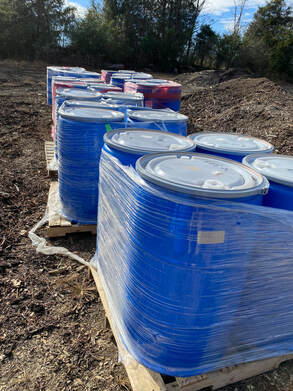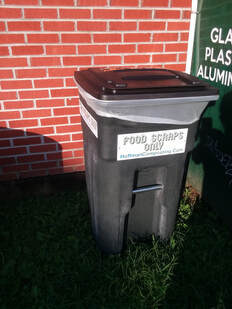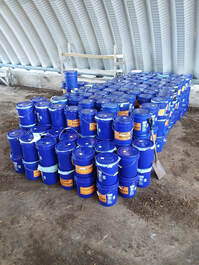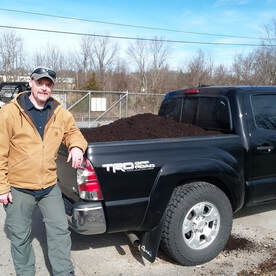|
Read below or click this link to download this guide for free.
|
| ||||||
Compost businesses have two revenue streams – inbound and outbound. “Inbound” refers to revenue from material that is brought to the composting facility. “Outbound” refers to revenue from material that leaves the composting facility. Both of these streams will be critical to your composting facility.
Inbound Revenue (Tipping and Collection Fees)

TIPPING FEES
One kind of inbound compost business revenue is the tipping fee that someone has to pay to dump what they consider waste. Landfills charge different tipping fees for different kinds of waste. For example, the landfill that serves the area where my composting facility is located charges about $45 per ton for Municipal Solid Waste. Municipal Solid Waste (MSW) is what most of us think of when we think of garbage. That same facility may charge a different rate for Construction and Demolition (C&D) waste.
As a composting business, the tipping fee you charge should be much less than the local landfill’s MSW tipping fee. There are two reasons for this:
Your tipping fee should also reflect the value that the material has for you and the hassle it will be for you to deal with. For example, I charge a tipping fee of $20 per ton for food scraps, but I don’t charge anything for wood chips or leaves. Even though food scraps are a fantastic feedstock, they are a challenge. They must be managed immediately to avoid problems with odors, pests, and public health issues. Also, their management is regulated by the state to protect the public from these nuisances. In short, accepting large amounts of food scraps at your facility brings a great deal of complication and cost. Wood chips, however, can be stockpiled relatively easily and without worry. Leaves represent a few challenges, including a smell that is pleasant but becomes overwhelming when you accept the large quantities that you’ll need for your process. For this reason, some facilities charge a tipping fee for leaves.
One kind of inbound compost business revenue is the tipping fee that someone has to pay to dump what they consider waste. Landfills charge different tipping fees for different kinds of waste. For example, the landfill that serves the area where my composting facility is located charges about $45 per ton for Municipal Solid Waste. Municipal Solid Waste (MSW) is what most of us think of when we think of garbage. That same facility may charge a different rate for Construction and Demolition (C&D) waste.
As a composting business, the tipping fee you charge should be much less than the local landfill’s MSW tipping fee. There are two reasons for this:
- Your disposal customers expect a lower price because they know that you will sell compost as a finished product; and
- The waste generator has probably gone through some trouble to produce Source Separated Organics (SSO).
Your tipping fee should also reflect the value that the material has for you and the hassle it will be for you to deal with. For example, I charge a tipping fee of $20 per ton for food scraps, but I don’t charge anything for wood chips or leaves. Even though food scraps are a fantastic feedstock, they are a challenge. They must be managed immediately to avoid problems with odors, pests, and public health issues. Also, their management is regulated by the state to protect the public from these nuisances. In short, accepting large amounts of food scraps at your facility brings a great deal of complication and cost. Wood chips, however, can be stockpiled relatively easily and without worry. Leaves represent a few challenges, including a smell that is pleasant but becomes overwhelming when you accept the large quantities that you’ll need for your process. For this reason, some facilities charge a tipping fee for leaves.

COLLECTION FEES
The other kind of inbound composting business revenue is collection fees. If you actually run around and collect food scraps – as I do – you will quickly discover that it is much more time-consuming than you had anticipated. You must charge for this service. Some people will react negatively to this. Knowing that you will sell your finished product, they think that you are being greedy by charging for collection. I find that it’s best not to argue or get offended even if the person is being rude about it. Just acknowledge that it’s too bad that the service can’t be free, but that it’s necessary and that it wouldn’t be economically possible to do it for free. After all, residents and businesses pay for regular trash pick up.
I always emphasized that people can drop their food scraps off at my facility for free. If they are willing to bring it to me, I’m happy to accept it. If they want me to come to their residence each week, it’s only natural to realize that that convenience has a cost. Depending on the situation, you may be able to charge less than what people are currently paying for trash collection. This will be very difficult, especially for residential.
The other kind of inbound composting business revenue is collection fees. If you actually run around and collect food scraps – as I do – you will quickly discover that it is much more time-consuming than you had anticipated. You must charge for this service. Some people will react negatively to this. Knowing that you will sell your finished product, they think that you are being greedy by charging for collection. I find that it’s best not to argue or get offended even if the person is being rude about it. Just acknowledge that it’s too bad that the service can’t be free, but that it’s necessary and that it wouldn’t be economically possible to do it for free. After all, residents and businesses pay for regular trash pick up.
I always emphasized that people can drop their food scraps off at my facility for free. If they are willing to bring it to me, I’m happy to accept it. If they want me to come to their residence each week, it’s only natural to realize that that convenience has a cost. Depending on the situation, you may be able to charge less than what people are currently paying for trash collection. This will be very difficult, especially for residential.

COMMERCIAL VS. RESIDENTIAL
When I was doing collection, I gave commercial service clients a better deal than residential. This is because of quantity. I get a lot more material per stop at coffee shops, etc. than I could ever get at a residence. Also, I want to maintain some commercial clients to pave the way for a future in which I can offer more cost-effective ways for restaurants to participate.
When I was doing collection, I gave commercial service clients a better deal than residential. This is because of quantity. I get a lot more material per stop at coffee shops, etc. than I could ever get at a residence. Also, I want to maintain some commercial clients to pave the way for a future in which I can offer more cost-effective ways for restaurants to participate.
Outbound Revenue

Outbound compost business revenue (money received from the sale of products like compost and mulch) is more straightforward for you and your potential customers. You need to have a good idea of what is available in your community and what the current prices are. You don’t necessarily need to offer the lowest price, because your product will likely be much better than your competitors’.
When you are in the very early stages, it’s fine to offer a single product – compost. Luckily for us, compost is both highly sought after and scarce enough that it brings customers to our facility. As your composting business grows, you may want to expand your product offering. I now offer compost and an enriched topsoil. I sell most of my product by the 1 cubic yard scoop, but I also bag the compost.
Remember, two types of revenue will sustain your compost business – inbound and outbound. When you think about the flows of cash, material, and work, you should always do so in terms of inbound and outbound. Learn about outbound products – what they should be, how to ensure high quality, and what they’ll cost to produce – here.
When you are in the very early stages, it’s fine to offer a single product – compost. Luckily for us, compost is both highly sought after and scarce enough that it brings customers to our facility. As your composting business grows, you may want to expand your product offering. I now offer compost and an enriched topsoil. I sell most of my product by the 1 cubic yard scoop, but I also bag the compost.
Remember, two types of revenue will sustain your compost business – inbound and outbound. When you think about the flows of cash, material, and work, you should always do so in terms of inbound and outbound. Learn about outbound products – what they should be, how to ensure high quality, and what they’ll cost to produce – here.